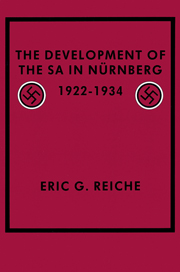Book contents
- Frontmatter
- Contents
- List of tables, figures, and maps
- Acknowledgments
- Introduction
- Abbreviations
- 1 Nürnberg and the emergence of National Socialism
- 2 Enter the stormtroopers: the Nürnberg SA, 1922–1923
- 3 “The guarantor of unity”: Nürnberg's SA between 1924 and 1929
- 4 Ready to assume power: the SA during the Great Depression
- 5 “The party bosses are our misfortune”: the Stegmann revolt, November 1932 to March 1933
- 6 The illusion of power: from the advent of the Third Reich to the Röhm putsch
- Conclusion
- Notes
- Bibliography
- Index
3 - “The guarantor of unity”: Nürnberg's SA between 1924 and 1929
Published online by Cambridge University Press: 21 October 2009
- Frontmatter
- Contents
- List of tables, figures, and maps
- Acknowledgments
- Introduction
- Abbreviations
- 1 Nürnberg and the emergence of National Socialism
- 2 Enter the stormtroopers: the Nürnberg SA, 1922–1923
- 3 “The guarantor of unity”: Nürnberg's SA between 1924 and 1929
- 4 Ready to assume power: the SA during the Great Depression
- 5 “The party bosses are our misfortune”: the Stegmann revolt, November 1932 to March 1933
- 6 The illusion of power: from the advent of the Third Reich to the Röhm putsch
- Conclusion
- Notes
- Bibliography
- Index
Summary
Between the Beer Hall Putsch and the onset of the Depression, the Nazi movement seemed to be at the nadir of its existence. As the fortunes of the Weimar Republic improved, that of the Nazis declined. In the “Golden Twenties,” Germany enjoyed relative prosperity. Its diplomatic prestige was enhanced by the Locarno agreement and Germany's entry into the League of Nations, and only a small minority of Germans continued to support Hitler. From 1920 to 1923, his party had fed on insecurity, instability, violence, and the hopes of the losers for a better future. The party would once again exploit these factors to great advantage after 1929. For the moment, there were fewer losers in Germany, including Nürnberg.
None of these developments meant a complete eclipse of the Nazi movement, and certainly not so in Nürnberg. In Germany as a whole, Nazi votes dropped from 6.5 percent in the May 1924 national elections to 2.6 percent four years later, but support for the Nazis in Bavaria remained proportionately at least twice as high. In Nürnberg, it never dropped below 10 percent of the total, and the Nazi movement thus remained a far from negligible factor in local politics, partly owing to Streicher's incessant and vitriolic attacks on the city's mayor.
Both the relative decline of the Nazi movement in Germany as a whole and its comparatively high profile in Bavaria and Nürnberg influenced the development of the Nürnberg SA during these years. So, of course, did Hitler's relative neglect of the SA during the first eighteen months after the NSDAP's reestablishment in early 1925.
- Type
- Chapter
- Information
- The Development of the SA in Nurnberg, 1922–1934 , pp. 50 - 88Publisher: Cambridge University PressPrint publication year: 1986



